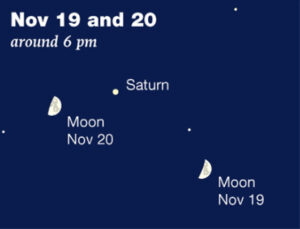Special to CosmicTribune.com, November 13, 2023, 2023
Excerpts from weekly Sky&Telescope report.
MONDAY, NOVEMBER 13
■ Perseus is high in the northeast these November evenings, below W-shaped Cassiopeia. The W is standing on end. To find the famous Double Cluster in Perseus, count down the segments of the W starting from the top. The third segment points almost straight down. Follow that direction down by twice its length, and there you are. Binoculars show the cluster-pair fairly easily.

Cassiopeia and Perseus over an aurora-silhouetted forest. Cassiopeia’s third segment, counting down from the top, points down to the Double Cluster, two little faint gray glows. The star-pattern of Perseus sprawls below them. Daniel Johnson.
■ New Moon (exact at 4:27 a.m. on the 13th EST).
TUESDAY, NOVEMBER 14
■ Around 7 or 8 p.m. this week, the Great Square of Pegasus stands in its level position very high when you face south.
The Square’s right (western) edge points very far down toward Fomalhaut. Saturn glows about two fists to Fomalhaut’s upper right.
■ M33, the low-surface-brightness Pinwheel Galaxy in Triangulum, may be gravitationally bound to the bigger, brighter Andromeda Galaxy 15° away. They’re at nearly the same distance from us. If you have a big telescope and a very dark sky . . .
THURSDAY, NOVEMBER 16
■ Vega is the brightest star high in the west on November evenings. Its little constellation Lyra extends to its left, pointing as always toward Altair, the brightest star high in the southwest.
Three of Lyra’s leading stars, after Vega, are interesting doubles. Barely above Vega is 4th-magnitude Epsilon Lyrae, the Double-Double. Epsilon forms one corner of a roughly equilateral triangle with Vega and Zeta Lyrae. The triangle is less than 2° on a side, hardly the width of your thumb at arm’s length.
Binoculars easily resolve Epsilon. And a 4-inch telescope at 100× or more should resolve each of Epsilon’s wide components into a tight pair.
Zeta is also a double star for binoculars; much tougher, but plainly resolved in a telescope. And Delta Lyrae, upper left of Zeta by a similar distance, is a much wider and easier binocular pair.
FRIDAY, NOVEMBER 17
■ Look south-southwest at nightfall for the waxing crescent Moon. It forms a huge, nearly equilateral triangle with Saturn far to its upper left and Altair far to its upper right. Each side of the triangle is nearly four fists at arm’s length long.
SATURDAY, NOVEMBER 18
■ By about 8 p.m. Orion is clearing the eastern horizon (depending on how far east or west you live in your time zone). Above Orion shines orange Aldebaran. Above Aldebaran is the little Pleiades cluster, the size of your fingertip at arm’s length.
 Down below Orion, Sirius rises around 10 p.m. No matter where in the sky they are, Sirius always follows two hours behind Orion.
Down below Orion, Sirius rises around 10 p.m. No matter where in the sky they are, Sirius always follows two hours behind Orion.
SUNDAY, NOVEMBER 19
■ This evening and tomorrow evening the Moon passes Saturn while going through first-quarter phase, as shown below. Here are the (probably) two most popular telescopic objects in the sky, just a few degrees apart.

You must be logged in to post a comment Login